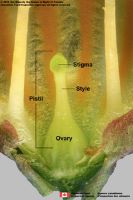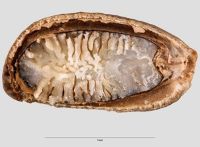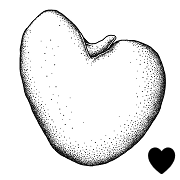Content is from Kirkbride et al. 2006Kirkbride et al. 2006:
Kirkbride JH, Jr, Gunn CR, and Dallwitz MJ. 2006. Family guide for fruits and seeds, vers. 1.0. Accessed September 2020-January 2022. URL: https://nt.ars-grin.gov/seedsfruits/keys/frsdfam/index.cfm ., without modification.
Updates are forthcoming.
 and mesocarpmesocarp:
and mesocarpmesocarp: absent and endocarpendocarp:
absent and endocarpendocarp: exposed.
exposed.
Fruits: Pistil(s) compound; 1; 1-pistillate; with carpels united. Fruit pericarpium; simple; drupedrupe:
(indehiscent drupe) a fleshy, indehiscent fruit with one more hard pits enclosing seeds, derived from single, superior, simple or compound ovary; (dehiscent drupe) a fruit with a dry or fibrous to fleshy or leathery outer husk that early to tardily breaks apart (or opens), exposing one or more nutlike pits enclosing the seeds , or samarasamara:
, or samarasamara:
a winged, indehiscent, dry fruit containing a single (rarely two) seed(s) (rarely of authors, but not Spjut); without persistent central column; crowned by stigmastigma:
(rarely of authors, but not Spjut); without persistent central column; crowned by stigmastigma:
the portion of the pistil receptive to pollen ; with stylar remenant(s); at apexapex:
; with stylar remenant(s); at apexapex:
the point farthest from the point of attachment, or the "tip" of an organ , or at base or nearly basalbasal:
, or at base or nearly basalbasal:
at or pertaining to the point of attachment; (of embryo) embryo occupies one end of the seed
; within accessory organ(s); within calyxcalyx:
the outer whorl of the perianth; all the sepals of a flower ; 1-seeded; 1-seeded; from 1–5 cm long to more than 10 cm long; 1–10 cm long; with (1–)3(–5)-carpellate; with carpels united; with carpels remaining united at maturity; without sterilesterile:
; 1-seeded; 1-seeded; from 1–5 cm long to more than 10 cm long; 1–10 cm long; with (1–)3(–5)-carpellate; with carpels united; with carpels remaining united at maturity; without sterilesterile:
lacking male and/or female reproductive parts; also, not producing fruit or seed
 carpels; without fleshy laterallateral:
carpels; without fleshy laterallateral:
(of embryo) embryo lies along the side of the seed, generally towards one end; of, at, or from the side; in grasses, can refer to the sides adjacent to the dorsal and ventral sides
appendage; not sulcatesulcate:
surface relief—having one or more elongate, relatively narrow and shallow depressions or grooves ; in transection tereteterete:
; in transection tereteterete:
approximately circular in cross section; width and thickness approximately equal
 , or compressedcompressed:
, or compressedcompressed:
flattened; in grasses, used to denote compression (not necessarily flattened) either laterally or dorsiventrally
; apexapex:
the point farthest from the point of attachment, or the "tip" of an organ not beaked; indehiscentindehiscent:
not beaked; indehiscentindehiscent:
not opening on its own, as in a fruit
 . Epicarpepicarp:
. Epicarpepicarp:
outer layer of fruit wall or pericarp, if divided into layers; note here used synonymously with exocarp black to purple, or brown (all shades), or blue, or red to purple, or orange, or white, or green (latter two for upper part of fruit); durable, or evanscent; glabrousglabrous:
black to purple, or brown (all shades), or blue, or red to purple, or orange, or white, or green (latter two for upper part of fruit); durable, or evanscent; glabrousglabrous:
without hairs
, or not glabrousglabrous:
without hairs
(with hairs) (reversely setulose by brittle irratant hairs); hairs short; hairs widely scattered, or dense; hairs red (rusty); hairs not glandularglandular:
surface relief—covered with small, raised secretory glands, regular or irregularly shaped, translucent or opaque, and maybe distinctly colored ; without armature, or with armature; with prickles (reddish-brown); without armature glochidiate; not smooth, or smooth; several to many longitudinally ribbedribbed:
; without armature, or with armature; with prickles (reddish-brown); without armature glochidiate; not smooth, or smooth; several to many longitudinally ribbedribbed:
surface relief—wide, prominent, linear ridges that are generally rounded and longitudinally situated on the surface , or wrinkledwrinkled:
, or wrinkledwrinkled:
surface relief—shallow, irregular folds and furrows covering the surface; appearing overall though crumpled and then spread out ; without wing(s), or with wing(s); 2-winged; with wing(s) laterallateral:
; without wing(s), or with wing(s); 2-winged; with wing(s) laterallateral:
(of embryo) embryo lies along the side of the seed, generally towards one end; of, at, or from the side; in grasses, can refer to the sides adjacent to the dorsal and ventral sides
; without apicalapical:
at or pertaining to the end of the seed or fruit distal from its point of attachment (i.e., base)
respiratory hole. Mesocarpmesocarp:
the middle layer of the pericarp, if divided into layers present, or absent; fibrousfibrous:
present, or absent; fibrousfibrous:
texture—long, flexible threads, thicker than hairs, that densely cover and obscure the surface , or fleshy (both equally dissolute), or thick; composed of 1 unified layer; without lactiform cavity system; & endocarpendocarp:
, or fleshy (both equally dissolute), or thick; composed of 1 unified layer; without lactiform cavity system; & endocarpendocarp:
the inner layer of the pericarp, if divided into layers not sharply differentiated. Endocarpendocarp:
not sharply differentiated. Endocarpendocarp:
the inner layer of the pericarp, if divided into layers present; not separating from exocarpexocarp:
present; not separating from exocarpexocarp:
outer layer of fruit wall or pericarp, if divided into layers; note here used synonymously with epicarp ; thick, or woodywoody:
; thick, or woodywoody:
texture—consisting mainly of indurate lignified tissues, characteristic of or resembling wood
, or thin, or crustaceouscrustaceous:
texture—thin, dry, indurate, and brittle
, or fibrousfibrous:
texture—long, flexible threads, thicker than hairs, that densely cover and obscure the surface , or spongyspongy:
, or spongyspongy:
soft, light, discontinuous but cohesive, and somewhat resilient
; not splitting into 1-seeded pyrenes; stone unilocular; not smooth, or smooth; with pits, or reticulatereticulate:
surface relief—netted, raised walls or concave grooves forming a net-like surface pattern with flat, concave, or convex interspaces , or rugoserugose:
, or rugoserugose:
wrinkled , or warts, or furrow(s), or wrinkles (& 1 to many ridges & 1 to 2 longitudinallongitudinal:
, or warts, or furrow(s), or wrinkles (& 1 to many ridges & 1 to 2 longitudinallongitudinal:
of or relating to length or the lengthwise dimension
grooves), or ridges; without wing; without operculumoperculum:
a dehiscent cap (or lid) of a seed or fruit that opens during germination or dehiscence ; without secretory cavities; without grooves, or with grooves; with longitudinallongitudinal:
; without secretory cavities; without grooves, or with grooves; with longitudinallongitudinal:
of or relating to length or the lengthwise dimension
ridges, or without longitudinallongitudinal:
of or relating to length or the lengthwise dimension
ridges; without fracturing longitudinallongitudinal:
of or relating to length or the lengthwise dimension
ridges. Funiculusfuniculus:
(alt. funicle) stalk connecting the ovule (later seed) to the ovary (later fruit) placenta not persisting in fruit after seed shed.
not persisting in fruit after seed shed.
Seeds: Arilaril:
(broad sense) appendicular structure that wholly or partly envelops a seed and is produced from or a modification of the funicle, raphe, or outer integument; usually fleshy or pulpy, sometimes spongy or tufted-capillate, often brightly colored absent. Seed larger than minute; ovateovate:
absent. Seed larger than minute; ovateovate:
2D shape—egg-shaped in outline, widest point is towards one end of the organ, the other end tapers gradually, attachment at or near the broad end (compare obovate, ovoid) , or reniformreniform:
, or reniformreniform:
2D or 3D shape—kidney-shaped , or ellipsoidellipsoid:
, or ellipsoidellipsoid:
3D shape—elliptic
, or obovoidobovoid:
3D shape—obovate
, or hippocrepiformhippocrepiform:
3D shape—horseshoe-shaped
; in transection tereteterete:
approximately circular in cross section; width and thickness approximately equal
 , or compressedcompressed:
, or compressedcompressed:
flattened; in grasses, used to denote compression (not necessarily flattened) either laterally or dorsiventrally
; not bowl shaped; not nutlike; without winglike beakbeak:
a usually firm, terminal appendage, sometimes tapered ; without caudatecaudate:
; without caudatecaudate:
tapering to a long, tail-like appendage appendage(s); at maturity with food reserves, or without apparent food reserves (Iodes); with endosperm; without canavanine. Sarcotestasarcotesta:
appendage(s); at maturity with food reserves, or without apparent food reserves (Iodes); with endosperm; without canavanine. Sarcotestasarcotesta:
pulpy or fleshy outer layer of the seed coat, simulates aril absent. Testatesta:
absent. Testatesta:
seed coat
 present; with viscid pellicle layer, or without pellicle layer; without fleshy or leatheryleathery:
present; with viscid pellicle layer, or without pellicle layer; without fleshy or leatheryleathery:
texture—moderately thick, tough, and very pliable
layer over hard layer; tight; surface smooth, or unsmooth; surface with merged raised features, or depressed features; surface longitudinally groovedgrooved:
surface relief—linear depressions that may be single or form a series of grooves over the surface , or pittedpitted:
, or pittedpitted:
surface relief—surface with small depressions in which the areas between the hollows do not take on the appearance of a true reticular net ; surface ribbedribbed:
; surface ribbedribbed:
surface relief—wide, prominent, linear ridges that are generally rounded and longitudinally situated on the surface ; without crease or line separating cotyledons from hypocotyl-radicle; without notch along margin where cotyledons from hypocotyl-radicle tip approach each other; without glands; without bristles; glabrousglabrous:
; without crease or line separating cotyledons from hypocotyl-radicle; without notch along margin where cotyledons from hypocotyl-radicle tip approach each other; without glands; without bristles; glabrousglabrous:
without hairs
; without wings; without collar; without operculumoperculum:
a dehiscent cap (or lid) of a seed or fruit that opens during germination or dehiscence ; colored; monochrome; brown (all shades) (at least); thin; not becoming mucilaginousmucilaginous:
; colored; monochrome; brown (all shades) (at least); thin; not becoming mucilaginousmucilaginous:
resembling mucilage; moist and sticky
when wetted; surrounding food reserve, or surrounding embryo. Hilumhilum:
on seeds, the scar indicating where the funiculus was attached; on grass caryopses, the scar visible on the outer fruit surface revealing where the seed is attached on the inner fruit wall surface; or in Asteraceae cypselae, the scar visible on the outer fruit wall revealing where the fruit was attached to the receptacle larger than punctatepunctate:
larger than punctatepunctate:
surface relief—dotted with pits or with translucent, sunken glands or with colored dots, similar to pitted . Endosperm development nuclear; copious, or moderate; fleshy, or fibrousfibrous:
. Endosperm development nuclear; copious, or moderate; fleshy, or fibrousfibrous:
texture—long, flexible threads, thicker than hairs, that densely cover and obscure the surface ; opaqueopaque:
; opaqueopaque:
not transmitting light
(white or yellow); smooth, or ruminateruminate:
testa or seed coat folded into the endosperm , or corrugated; with starch; without fatty acid containing cyclopropene; with apicalapical:
, or corrugated; with starch; without fatty acid containing cyclopropene; with apicalapical:
at or pertaining to the end of the seed or fruit distal from its point of attachment (i.e., base)
lobes, or without apicalapical:
at or pertaining to the end of the seed or fruit distal from its point of attachment (i.e., base)
lobes; without chlorophyll; without isodiametric faceted surface; without odor. Embryo differentiated from food reserve; well developed; 1 per seed; completely filling testatesta:
seed coat
 (no food reserve) to nearly filling testatesta:
(no food reserve) to nearly filling testatesta:
seed coat
 (trace or scanty food reserve); 0.2–1 times the length of food reserve; at one end of seed not extending into a depression or cup; axileaxile:
(trace or scanty food reserve); 0.2–1 times the length of food reserve; at one end of seed not extending into a depression or cup; axileaxile:
on or of the axis
and centric; foliatefoliate:
appearing leaf-like
; with spatulatespatulate:
2D shape—like a spatula; rounded at the apex, with base long and tapered; (of embryo) embryo is straight and axile and centric with the cotyledons expanded to form the shape of a spatula or spoon; (of cotyledons) cotyledons expanded and wider than the stalk but not invested into the stalk cotyledons (at least); straight, or arcuate; parallel to seed length; with cotyledons abruptly connected to hypocotyl-radicle, or gradually connected to hypocotyl-radicle; without coleorhiza; without simmondsin; without stomata; not green; with 2 or more cotyledons. Cotyledons 2; moderately developed, or well developed; 0.8 times length of embryo (at least); 2–9 times wider than hypocotyl-radicle; not concealing hypocotyl-radicle; not foliaceous, or foliaceous; thin, or thick (rarely); flat, or much folded, or irregularly-folded, or twice-folded; smooth, or wrinkledwrinkled:
cotyledons (at least); straight, or arcuate; parallel to seed length; with cotyledons abruptly connected to hypocotyl-radicle, or gradually connected to hypocotyl-radicle; without coleorhiza; without simmondsin; without stomata; not green; with 2 or more cotyledons. Cotyledons 2; moderately developed, or well developed; 0.8 times length of embryo (at least); 2–9 times wider than hypocotyl-radicle; not concealing hypocotyl-radicle; not foliaceous, or foliaceous; thin, or thick (rarely); flat, or much folded, or irregularly-folded, or twice-folded; smooth, or wrinkledwrinkled:
surface relief—shallow, irregular folds and furrows covering the surface; appearing overall though crumpled and then spread out ; with apicesapex:
; with apicesapex:
the point farthest from the point of attachment, or the "tip" of an organ entire; with margins separate; basally cordatecordate:
entire; with margins separate; basally cordatecordate:
2D shape—heart-shaped, with attachment at or near the broad end (compare obcordate) , or entire; equal in size; not punctatepunctate:
, or entire; equal in size; not punctatepunctate:
surface relief—dotted with pits or with translucent, sunken glands or with colored dots, similar to pitted dotted. Hypocotyl-radicle moderately developed, or well developed; straight; not thickened.
dotted. Hypocotyl-radicle moderately developed, or well developed; straight; not thickened.
Literature specific to this family: Kårehed, J. 2001. Multiplemultiple:
fruit formed from several flowers clustered in one mass
origin of the tropical forest tree family Icacinaceae. Amer. J. Bot. 88:2259–2274; Sleumer, H. 1972. Icacinaceae. In: C.G.G.J. van Steenis, ed., Flora malesiana, vol. 7, pp. 1–87. Noordhoff International Publishing, Leydon.
General references: Baillon, H.E. 1866–95. Histoire des plantes, 13 vols. Hachette & Co., Paris, Corner, E.J.H. 1976. The seeds of Dicots, esp. vol. 2. Cambridge University Press, New York, Cronquist, A. 1981. An integrated system of classification of flowering plants, 1,262 p. Columbia University Press, New York, Engler, A. & K. Prantl. 1924 and onward. Die Natürlichen Pflanzenfamilimien. W. Engelman, Leipzig, Goldberg, A. 1986 (dicots) & 1989 (monocots). Classification, evolution, and phylogeny of the familes of Dicotyledons. Smithsonian Contr. Bot. 58 for dicots (314 pp.) & 71 for monocots (74 pp.). [Goldberg's illustrations are reproduced from older publications and these should be consulted], Gunn, C.R. & J.V. Dennis. 1976. World guide to tropical drift seeds and fruits, 240 pp. The New York Times Book Co., New York, Gunn, C.R. & C.A. Ritchie. 1988. Identification of disseminulesdisseminule:
detachable plant part capable of being disseminated and of propagating, commonly a seed or fruit
listed in the Federal Noxious Weed Act. Techn. Bull. U.S.D.A. 1719:1–313, Gunn, C.R., J.H. Wiersema, C.A. Ritchie, & J.H. Kirkbride, Jr. 1992 & amendments. Families and genera of Spermatophytes recognized by the Agricultural Research Service. Techn. Bull. U.S.D.A. 1796:1–500, Mabberley, D.J. 1987. The plant-book, 706 p. Cambridge University Press, Cambridge, Roosmalen, M.G.M. van. 1985. Fruits of the Guianan flora, 483 pp. Institute of Systematic Botany, Wageningen Agricultural University. Drukkerij Veenman B.V., Wageningen, Spjut, R.W. 1994. A systematic treatment of fruit types. Mem. New York Bot. Gard. 70:1–182, and Steenis, C.G.G.J. van, ed. 1950 onwards. Flora Malesiana, ser. 1. Spermatophyta. Noordhoff-Kolff, Djakarta.